
Damselfish are those within the subfamilies Abudefdufinae, Chrominae, Lepidozyginae, Pomacentrinae, and Stegastenae within the family Pomacentridae. Most species within this group are relatively small, with the largest species being about 30cm in length. Most damselfish species exist only in marine environments, but a few inhabit brackish or fresh water. These fish are found globally in tropical, subtropical, and temperate waters.
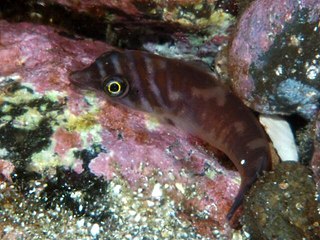
Clingfishes are fishes of the family Gobiesocidae, the only family in the order Gobiesociformes. These fairly small to very small fishes are widespread in tropical and temperate regions, mostly near the coast, but a few species in deeper seas or fresh water. Most species shelter in shallow reefs or seagrass beds, clinging to rocks, algae and seagrass leaves with their sucking disc, a structure on their chest.
Mucophagy is defined as the act of feeding on mucus of fishes or invertebrates. Also, it may refer to consumption of mucus or dried mucus in primates.

The shore clingfish, Lepadogaster lepadogaster, is a clingfish of the family Gobiesocidae. It is found in the Mediterranean Sea and adjacent Atlantic Ocean north to Galicia, Spain.

The masked hamlet is a species of marine ray-finned fish, a sea bass from the subfamily Serraninae which is part of the family Serranidae, which also includes the groupers and anthias. This species is found in the western Atlantic Ocean in the Caribbean Sea and has been recorded from the coast of Central America from Quintana Roo in Mexico to Bocas del Toro in Panama and from Jamaica to Puerto Rico, as well as in the Turks and Caicos and the Cayman Islands. Its specific name refers to Providencia Island, Colombia where the type was collected. It was also recorded from other islands in the Archipelago of San Andrés, Providencia and Santa Catalina. They are a unique species in the Hypoplectrus genus, defined by their unique color morph. Their behavior is largely similar to that of other hamlets, especially in their diet and egg-trading spawning patterns.
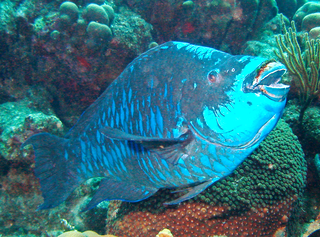
The midnight parrotfish is a species of parrotfish that inhabits coral reefs mainly in the Caribbean, Bahamas, and Florida.

The bar jack, also known as the carbonero, red jack, blue-striped cavalla or passing jack, is a common species of inshore marine fish classified in the jack family, Carangidae. The bar jack is distributed through the western Atlantic Ocean from New Jersey and Bermuda in the north to Venezuela and possibly Brazil in the south, with the largest population in the Gulf of Mexico and West Indies. The bar jack is most simply distinguished from similar jacks by its dark horizontal bar which runs along the back and down the caudal fin, often accompanied by an electric blue stripe immediately below it. Other more detailed differences include dentition and soft ray counts. The bar jack is a moderately large species, growing to a recorded maximum of 65 cm and a weight of 6.8 kg. The species inhabits clear shallow waters, often over coral reefs where it lives either solitarily or in large schools, taking various fishes, crustaceans and cephalopods as prey. Studies in Cuba indicate spawning occurs between March and August, with sexual maturity reached at 26 cm. It is a relatively popular sport fish and can be caught on light tackle with a variety of lures and baits. It is considered to be a good food fish, however many recorded ciguatera cases are attributed to the species, with most cases reported on the island of St. Thomas traced to this single species.
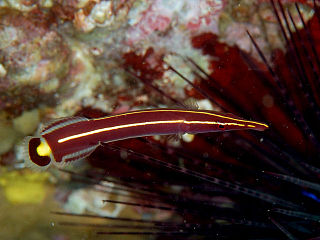
Diademichthys lineatus, commonly known as the long-snout clingfish or urchin clingfish, is a species of marine fish in the family Gobiesocidae.
Hypoplectrus gummigutta, commonly called the golden hamlet, is a species of marine ray-finned fish. They are sea bass from the subfamily Serraninae and the greater family Serranidae, which also includes the groupers and anthias. The golden hamlet was first described in 1852 by zoologist Felipe Poey (1799-1891) as Plectropoma gummigutta before being given its accepted name: Hypoplectrus gummigutta. It is found in the western Atlantic Ocean and occasionally makes its way into the aquarium trade.

Gorgasia is one of the two genera that belong to the subfamily Heterocongrinae. This genus is classified by the behavioral pattern of burrowing 75% of their bodies in the sandy substrate they live in and protruding their upper body into the water current above, giving the appearance that they are planted into the ground. This protruding behavior serves a multipurpose functionality to their survival.
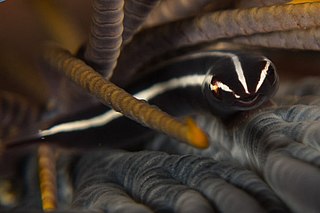
Discotrema is a genus of clingfishes found on reefs in the Indo-Pacific where they live on crinoids. These tiny fish have distinctive pattern consisting of long white or yellow lines along their body.
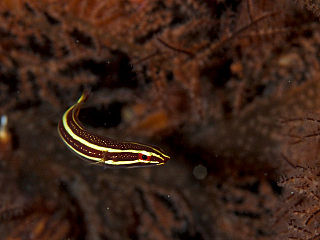
Lepadichthys is a genus of clingfishes native to the Indian and Pacific Oceans.

Lepadogaster is a genus of clingfishes native to the eastern Atlantic Ocean extending into the Mediterranean Sea. Lepadogaster belongs to class Actinopterygii. This means that they share many of the same characteristics as eels, ray-finned fish, and sea horses to name a few. The main characteristic of all of them though is having fin rays. These fin rays are made of webbed skin and are attached to portions of the body that connect fins to the bones. Lepadogaster species have a distinct difference in the formation of their dorsal and anal fins. While most other ray-finned fish spines, branched fin-rays, and middle radials, Lepadogaster species do not have these. Instead, they have cartilage in place of the mentioned features. These clingfish are mainly found near the rocky coasts and inside intertidal zones. Lepadogaster is known mostly as a clingfish, meaning that it spends most of its time attached to the surface of rocks.
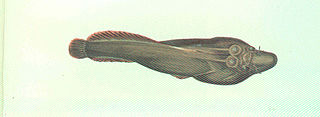
Lepadogaster purpurea, the Cornish sucker, is a species of clingfish from the family Gobiesocidae. It is found in the eastern North Atlantic Ocean and in the Mediterranean Sea.

Diplecogaster bimaculata, the two-spotted clingfish, is a species of fish in the family Gobiesocidae found in Black Sea, Mediterranean Sea and Atlantic Ocean where it is found on rocks and among seagrass or shell beds.
Diplecogaster tonstricula, the Eastern Atlantic cleaner clingfish, is a species of clingfish from the family Gobiesocidae which is found in the tropical eastern North Atlantic Ocean. It has been observed cleaning larger species of fish.

Lepadichthys frenatus, the bridled clingfish, is a species of clingfish from the family Gobiesocidae. It is found on shallow reefs in the western Pacific Ocean.
Opeatogenys gracilis is a species of clingfish from the family Gobiesocidae which is found in the Mediterranean Sea and in the eastern Atlantic Ocean. Suggested common names for this species are the pygmy clingfish and the seagrass clingfish.

Cirrhilabrus briangreenei, the Latigo fairy wrasse, is a species of wrasse that lives in the waters of Indonesia, Philippines, Western Pacific Ocean. It can be found at depths from 82 - 110 m, and was known for a long time in the aquarium trade but only in 2020 received a scientific name. This species can reach a total length of 1.57 - 2.76 cm. It feeds on amphipods, brine shrimps, copepods, cyclops, Daphnia salina, fish larvae, invertebrates, lobster eggs and zooplankton.

Haemulon squamipinna is a species of marine ray-finned fish, a grunt belonging to the family Haemulidae. It is found in the western Atlantic Ocean where it is endemic to Brazil, here it is locally known as Xira Amarela, and occurs along the coast from the states of Ceará to Bahia. It grows to about 20 cm (7.9 in) in length, feeds at night on benthic invertebrates, and is important for subsistence fisheries along the northeastern Brazilian coast. It forms large schools that can number in the thousands, sometimes with Haemulon aurolineatum. Juveniles are often found in shallow reefs at deths of 2 to 5 m while adults are found in deeper areas at 5 to 30 m.















